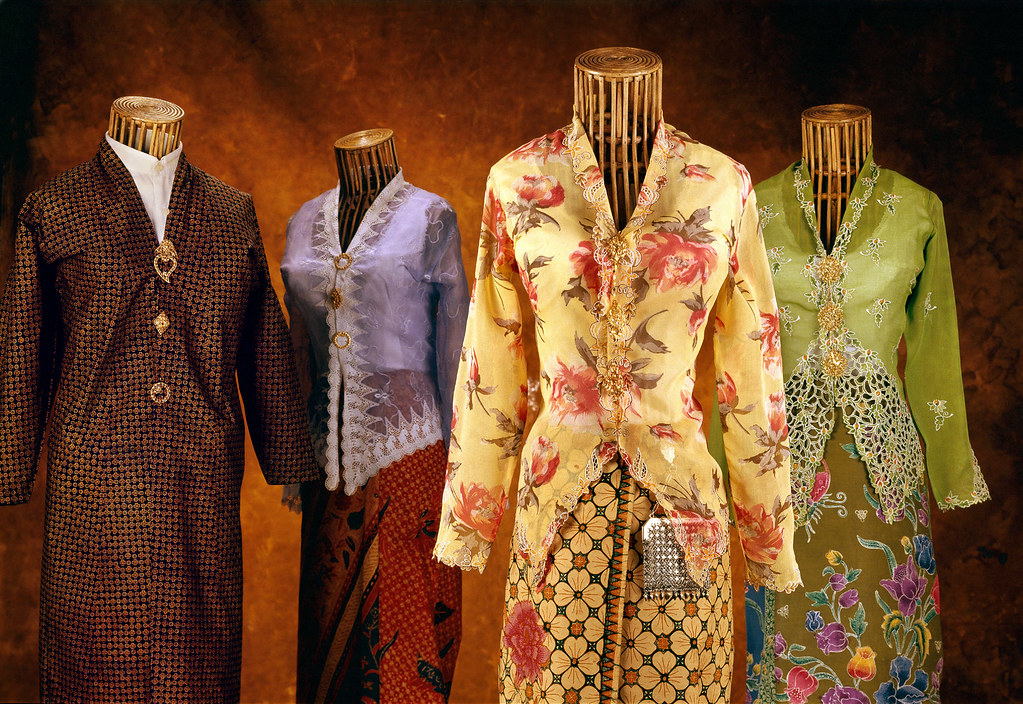Graphic Designers: Ng Pei Kie, Teng Yoke Kim
Lighting and Logistics Support: Alvin Lee Liang Meng
Asian Civilisations Museum
Design of the Year - President*s Design Award 2006
 "Nyonya Kebaya", collection of the late Datin Seri Endon Mahmood, Singapore, 2006
"Nyonya Kebaya", collection of the late Datin Seri Endon Mahmood, Singapore, 2006"Each new project creates opportunities for new learning, new discoveries and new experiences for me in order to evolve new design ideas and concepts. To make breakthroughs for each design project is the real challenge." Sebastian Chun
The 6 special exhibitions at the Asian Civilisations Museum – Spirit of Wood, Sari to Sarong, From the Land of the Ottoman Sultans, Nyonya Kebaya, Journey of Faith, and Power Dressing – deftly cross-pollinate design and theatrical elements, to provide viewers with a complete and immersive visual experience. Rather than tread the conventional path of transporting the visitor back into the past, the exhibitions employ the language of theatre to “float” the visitor in a dreamlike panorama of images and memories evocative of the past. The exhibitions show consistent quality and attention to detail throughout, and elegantly utilize design to enhance the subject matter.
As Head of Design Services at the Asian Civilisations Museum, Sebastian Chun has handled 500-year old textiles from India and Indonesia, ancient antiquities from the Roman Empire in the Vatican collection, Buddhist sculptures from Pakistan and palace treasures from the Ottoman Empire. His careful handling of each piece and the close attention to design details have earned the praise and respect of international visitors including visiting dignitaries.
Sebastian’s distinct oeuvre derives from diverse interests and experience gleaned from years of being a free-lance design consultant. Fashion, advertising, interior design, corporate design work come
into play in his design explorations. Theatre, however, remains the source of his greatest inspiration.
“I have been working in Theatre Design for the past 2 decades. Theatre is more intelligent and imaginative than movies. Through my design explorations, I fuse Museum Exhibition design, my newly found ‘baby’ with Theatre Design & Interior Design technique.”
The sense of the dramatic can be seen in Hidden Faces, an exhibition of 48 Noh Masks and 10 Noh Theatre Kimonos. Pebbles representing water are used to create stylized ponds and a stream. A floating
lamp transmutes into a lotus floating on the pond. Pine trees, used in traditional Noh Theatre to symbolize heaven, earth and humans become the third wall in his re-creation of a Noh Theatre space. The Japanese filmmaker Kurosawa’s influence is seen in the ‘endless corridor’, multi-screen panels and the interplay of shadows and light. The kimonos are displayed in two rooms which face each other directly, as if they are contemplating or conversing with the other. In contrast with the sense of antiquity, contemporary graphics
of sakura and pine trees are used to create a stylized natural environment. Black, red and gold, colours that symbolize wealth and prestige in Japan, are used to represent the high status of Noh Theatre in Japan.
"Nyonya Kebaya", Singapore, 2006
Peranakan Cabinet, Singapore, 2006
“My various experiences visiting international museums have convinced me that Singapore is at the forefront of the new modes of presenting museum exhibitions. Here, design is closely integrated with the display of the artifacts and exhibition themes. It is both artistic and educational”
Edwin Lee, Principal Architect, CPG Consultants agrees, “I personally find his museum exhibition designs on par and even better than some of the other museums around the world. Some of his outstanding works are ‘From the Land of Ottoman Sultans’ which featured enclaves and intimate corridor exhibition spaces reflective
of the palaces interior in spirit. The inventive use of lighting cast on panels with cut outs created interesting shadows on the exhibits. In the case of the Vatican's Journey of Faith exhibition, it was a totally different design approach with a very modern minimalist design using strategically placed light box tubes to cast a spiritual glow over the religious icons. On the other hand, Power Dressing exhibition, an exhibition on Chinese textiles, one has the impression of walking on a Chinese bridge whilst looking out onto 'sails' of Chinese gowns of ornate intricate patterns.”
Sebastian regularly conducts design tours for each exhibition and engages with students and members of the public in dialogues, design seminars and forums for international exhibition designers. He also regularly accompanies press, media and important foreign dignitaries on tours of the exhibition to talk about his design rationale. “I believe all these interactions help to create and promote better awareness of design as a whole”
Advice to emerging designers:
“Get a good foundation and do research for each subject that you are working on. Aim for the result, not the reward. Develop an awareness of all kind of arts, culture and people. Be open minded and not self-indulgent, each design and creation should be self-explanatory and be current - a sense of today - to date!”



No comments:
Post a Comment